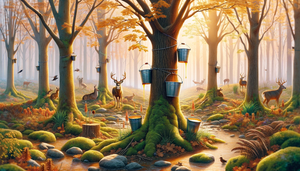Ecotourism and Wildlife Conservation
Jul 08, 2024
Imagine wandering through a serene forest, the scent of maple syrup filling the crisp air, birds singing in the background, and the crunch of leaves underfoot. This picturesque scene is a reality in Sugarbushes, where traditional methods of producing maple syrup meet the modern world of ecotourism. This blend delights visitors and plays a crucial role in wildlife conservation.
The Magic of Sugarbushes
Sugarbushes are special forests where sugar maple trees grow in abundance. These trees are tapped to produce the maple syrup that many of us cherish. But beyond their sweet offerings, sugarbushes are vital ecosystems. They support diverse wildlife, from deer and birds to insects and plants, creating a rich tapestry of life.
Traditional Maple Syrup Production
- Tree Tapping: Sugar maple trees are tapped in late winter to collect sap.
- Sap Collection: Buckets or tubing systems gather the sap, which flows as temperatures fluctuate between freezing nights and thawing days.
- Boiling Process: The sap is boiled down in a sugarhouse, transforming into the golden syrup we love.
This time-honored process connects us to nature, and each drop of syrup reflects hard work and harmony with the environment.
Ecotourism: A Catalyst for Conservation
Ecotourism in sugarbushes brings visitors closer to nature, educating them on sustainable practices while directly supporting conservation efforts. Here’s how:
Funding Conservation
- Entrance Fees and Tours: Funds collected from visitors go directly into maintaining the sugarbush and protecting wildlife habitats.
- Workshops and Experiences: Activities like syrup-making workshops and guided nature walks educate the public and generate income for conservation projects.
Promoting Sustainable Practices
- Education: Ecotourism educates visitors on the importance of sustainable practices, encouraging them to support eco-friendly products.
- Community Involvement: Local communities are engaged in conservation efforts, ensuring that traditional knowledge and practices are preserved and passed down.
Supporting Biodiversity
- Habitat Protection: Revenue from ecotourism helps preserve critical habitats, ensuring the survival of various plant and animal species.
- Research and Monitoring: Funds support wildlife and forest health research, leading to better conservation strategies.
The Role of Maple Syrup Lovers and Food Enthusiasts
Maple syrup lovers, foodies, and breakfast fans have a unique role in supporting these initiatives. By choosing maple syrup from sustainable sugarbushes, they contribute to conservation efforts. Here are some ways to get involved:
Choose Sustainably Sourced Products
Look for certifications or labels that indicate sustainable practices. Supporting these products helps ensure that sugarbushes remain healthy and productive.
Participate in Ecotourism Activities
- Visit a Sugarbush: Plan a visit to a Sugarbush to see the production process firsthand and learn about the ecosystem.
- Join Workshops: Participate in syrup-making workshops or nature tours to deepen your understanding and appreciation of these environments.
Advocate and Educate
Share your knowledge about the benefits of sustainable maple syrup and ecotourism with others. Advocacy helps spread the word and increases support for these initiatives.
Ecotourism in sugarbushes offers a unique blend of enjoyment and education. Visitors can experience the magic of maple syrup production while contributing to wildlife conservation. By supporting these initiatives, we help preserve the rich biodiversity of these forests and ensure that future generations can continue to enjoy the sweet, wholesome goodness of sustainably produced maple syrup.
Frequently Asked Questions (FAQs)
What is a sugarbush?
A sugarbush is a forest stand primarily composed of maple sugar trees managed for maple syrup production.
How does ecotourism support wildlife conservation?
Ecotourism generates funds through entrance fees, tours, and workshops, which are used to maintain and protect wildlife habitats and support conservation research.
How can I ensure I’m buying sustainable maple syrup?
Look for products with certifications or labels indicating they follow sustainable practices.
Can visiting a sugarbush impact the environment negatively?
Ecotourism minimizes negative impact when managed responsibly and can greatly benefit conservation efforts.
What activities can I do in a sugarbush?
Visitors can engage in syrup-making workshops and guided nature walks and learn about sustainable forest management practices.


